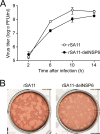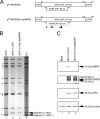Reverse Genetics System Demonstrates that Rotavirus Nonstructural Protein NSP6 Is Not Essential for Viral Replication in Cell Culture
- PMID: 28794037
- PMCID: PMC5640853
- DOI: 10.1128/JVI.00695-17
Reverse Genetics System Demonstrates that Rotavirus Nonstructural Protein NSP6 Is Not Essential for Viral Replication in Cell Culture
Abstract
The use of overlapping open reading frames (ORFs) to synthesize more than one unique protein from a single mRNA has been described for several viruses. Segment 11 of the rotavirus genome encodes two nonstructural proteins, NSP5 and NSP6. The NSP6 ORF is present in the vast majority of rotavirus strains, and therefore the NSP6 protein would be expected to have a function in viral replication. However, there is no direct evidence of its function or requirement in the viral replication cycle yet. Here, taking advantage of a recently established plasmid-only-based reverse genetics system that allows rescue of recombinant rotaviruses entirely from cloned cDNAs, we generated NSP6-deficient viruses to directly address its significance in the viral replication cycle. Viable recombinant NSP6-deficient viruses could be engineered. Single-step growth curves and plaque formation of the NSP6-deficient viruses confirmed that NSP6 expression is of limited significance for RVA replication in cell culture, although the NSP6 protein seemed to promote efficient virus growth.IMPORTANCE Rotavirus is one of the most important pathogens of severe diarrhea in young children worldwide. The rotavirus genome, consisting of 11 segments of double-stranded RNA, encodes six structural proteins (VP1 to VP4, VP6, and VP7) and six nonstructural proteins (NSP1 to NSP6). Although specific functions have been ascribed to each of the 12 viral proteins, the role of NSP6 in the viral replication cycle remains unknown. In this study, we demonstrated that the NSP6 protein is not essential for viral replication in cell culture by using a recently developed plasmid-only-based reverse genetics system. This reverse genetics approach will be successfully applied to answer questions of great interest regarding the roles of rotaviral proteins in replication and pathogenicity, which can hardly be addressed by conventional approaches.
Keywords: NSP6; reverse genetics; rotavirus; viral replication.
Copyright © 2017 American Society for Microbiology.
Figures





Similar articles
-
Recombinant Rotaviruses Rescued by Reverse Genetics Reveal the Role of NSP5 Hyperphosphorylation in the Assembly of Viral Factories.J Virol. 2019 Dec 12;94(1):e01110-19. doi: 10.1128/JVI.01110-19. Print 2019 Dec 12. J Virol. 2019. PMID: 31619556 Free PMC article.
-
Generation of Recombinant Rotavirus Expressing NSP3-UnaG Fusion Protein by a Simplified Reverse Genetics System.J Virol. 2019 Nov 26;93(24):e01616-19. doi: 10.1128/JVI.01616-19. Print 2019 Dec 15. J Virol. 2019. PMID: 31597761 Free PMC article.
-
Reverse Genetics System for a Human Group A Rotavirus.J Virol. 2020 Jan 6;94(2):e00963-19. doi: 10.1128/JVI.00963-19. Print 2020 Jan 6. J Virol. 2020. PMID: 31645445 Free PMC article.
-
Human Rotavirus Reverse Genetics Systems to Study Viral Replication and Pathogenesis.Viruses. 2021 Sep 8;13(9):1791. doi: 10.3390/v13091791. Viruses. 2021. PMID: 34578372 Free PMC article. Review.
-
Generation of recombinant rotaviruses from just 11 cDNAs encoding a viral genome.Virus Res. 2020 Sep;286:198075. doi: 10.1016/j.virusres.2020.198075. Epub 2020 Jun 24. Virus Res. 2020. PMID: 32592818 Review.
Cited by
-
Understanding the penetrance of intrinsic protein disorder in rotavirus proteome.Int J Biol Macromol. 2020 Feb 1;144:892-908. doi: 10.1016/j.ijbiomac.2019.09.166. Epub 2019 Nov 15. Int J Biol Macromol. 2020. PMID: 31739058 Free PMC article.
-
Reverse Genetics Reveals a Role of Rotavirus VP3 Phosphodiesterase Activity in Inhibiting RNase L Signaling and Contributing to Intestinal Viral Replication In Vivo.J Virol. 2020 Apr 16;94(9):e01952-19. doi: 10.1128/JVI.01952-19. Print 2020 Apr 16. J Virol. 2020. PMID: 32051268 Free PMC article.
-
The prevention strategies of swine viruses related to xenotransplantation.Virol J. 2023 Jun 13;20(1):121. doi: 10.1186/s12985-023-02090-3. Virol J. 2023. PMID: 37312151 Free PMC article. Review.
-
Nonstructural Protein σ1s Is Required for Optimal Reovirus Protein Expression.J Virol. 2018 Mar 14;92(7):e02259-17. doi: 10.1128/JVI.02259-17. Print 2018 Apr 1. J Virol. 2018. PMID: 29321319 Free PMC article.
-
Conserved Rotavirus NSP5 and VP2 Domains Interact and Affect Viroplasm.J Virol. 2020 Mar 17;94(7):e01965-19. doi: 10.1128/JVI.01965-19. Print 2020 Mar 17. J Virol. 2020. PMID: 31915278 Free PMC article.
References
-
- Tate JE, Burton AH, Boschi-Pinto C, Parashar UD, World Health Organization-Coordinated Global Rotavirus Surveillance Network. 2016. Global, regional, and national estimates of rotavirus mortality in children <5 years of age, 2000-2013. Clin Infect Dis 62(Suppl 2):S96–S105. doi:10.1093/cid/civ1013. - DOI - PMC - PubMed
-
- Estes MK, Greenberg HB. 2013. Rotaviruses, p 1347–1401. In Knipe DM, Howley PM (ed), Fields virology, 6th ed Lippincott Williams & Wilkins, Philadelphia, PA.
Publication types
MeSH terms
Substances
LinkOut - more resources
Full Text Sources
Other Literature Sources
Medical

